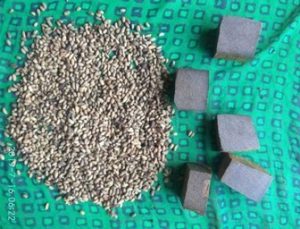
Dried neem seeds at a household in Bhalumuda.
Innovation is creating something out of nothing. This comes true as in case of the people of Bhalumuda village in Tamnar tehsil of Chhattisgarh’s Raigarh district. A team from Environics Trust visited the village that is dominated with tribal people. The village lies in a coal-rich area known popularly as the Mand-Raigarh coal field. The area is filled with numerous coal mines, thermal power plants and iron and steel works and is a pit of pollution and health-related ailments. At first sight, the village seems to be an ordinary village with mud houses, cattle roaming on the streets of the village, people gossiping in tea shops and women and children bathing under the community water tanks. But once you enter a house, you will witness a large area mopped with cow dung and upon it many neem seeds left to dry.
Out of curiosity we asked the women of the house about the neem seeds. To this they said that the neem seeds are used to make bathing soap which is used by all members of the family. Since neem is a medicinal plant, the people of the village find it beneficial to eliminate skin diseases that are caused because of the polluted air and water. Many people who complained of perforated skin rashes due to bathing in polluted water are not facing any of such problems since they have started using their home-made neem soap.
The procedure of making such soaps is quite simple. The neem seeds are peeled from their fruits, washed and dried in the sun. Subsequently it is ground to a fine powder using mortar and pestle. Washing soda (Na2CO3) is added to this fine powder and enough water is added to make a semi-solid paste. This paste is molded into a large cake which is cut with a thread to make bricks of soap. These bricks are then dried in the sun to harden to be later used as soap. Although, the soap does not form lather, it is efficient in cleansing and washing. A single bar of soap, if used by a family of 4 can last for 1 week.
The benefits of using these soaps are they do not pollute the water bodies because they do not produce any lather. Also, the product is 100% natural and is obtained from the nearby Silot Reserve Forest free of cost; therefore, the cost of purchasing soap is saved.
Although the product is not a high-quality product, it definitely shows that there are many innovative techniques that are known by the village and tribal communities because of which they have survived and will survive in the long run. If the product can be made better, there will be a good chance for it to get commercialised and act as a source of income for the tribals of Bhalumuda.
Raihanul Sarkar

Recent Comments